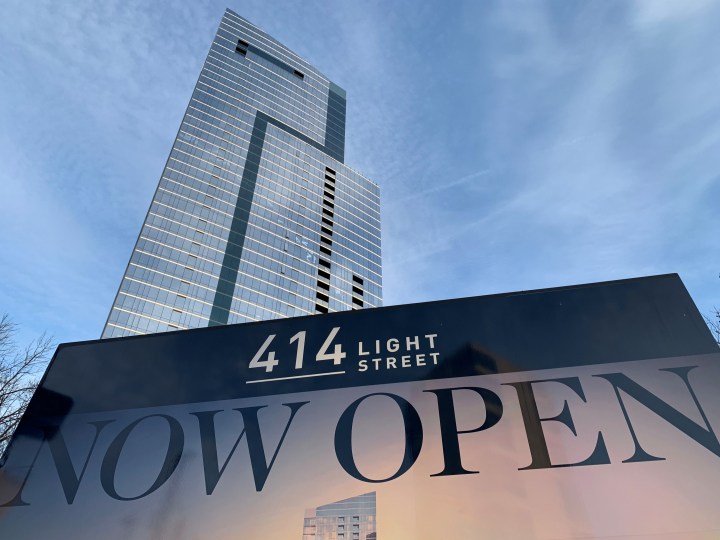
The rise of the high-rise

In the sleek lobby of a new apartment building in Baltimore, there’s modern art on the walls and cushy benches for lounging. Ayana Lugo is right at home in the 18-story tower.
“I’m from Manhattan,” she said. “I grew up in a high rise. I lived on the 31st floor.”
Lugo was on her way out to run some errands with her small dog Goliath. They planned to walk to a supermarket right up the street, then hit the liquor store and maybe stop by the nut shop for some peanuts.

“We’re just going to do a big loop,” she said.
Being able to do all that is one big reason for the recent boom in high-rise construction. More people want to walk to the stuff they need, said Jenny Schuetz, who researches housing and land policy at the Brookings Institution. There’s only so much land surrounding those clusters of restaurants, grocery stores, parks and shops, “so the way that you squeeze more people into an urban core is by stacking them on top of one another vertically,” she said.
The growing cost of land is another factor. Developers need to build more units to make a profit. High-rises are nothing new in cities like New York and San Francisco that can’t grow, “but we’re definitely seeing in markets like Denver and Houston and Nashville, places where people normally would have expected to have a little more space and spread out, that people are really demanding these neighborhood amenities,” Schuetz said. “So that’s driving the type of development we see.”
Even in suburbs, new developments are mimicking the feel of an urban center, with apartments built on top of retail shops in eight- to 10-story buildings.
In the 1990s, more than 90% of new apartment buildings topped out at four stories, according to research firm Yardi Matrix. Low-rise buildings make up less than half of new construction today.
Yet with all these new apartments, rents are still rising. That’s because they’re all pretty much full, said Yardi’s director of business intelligence, Doug Ressler. The national occupancy rate is more than 95%.
“Basically it’s the economics of supply and demand,” he said. “There’s more demand than there is supply.”
The housing crisis can be thanked for that. Construction nearly ground to a halt and is still catching up, said Caitlin Walter, vice president of research at the National Multifamily Housing Council, which represents landlords and developers.
“You’re looking at 10 years where we weren’t building enough,” she said. “And so unfortunately, while we are building, it’s not really making a dent in the affordability problems so far in most places.”
Many of the most expensive cities make it hard to build up, with restrictions on density and height. Local leaders and homeowners often fight against taller buildings.
“In most of these places that have the worst affordability problems, like California, they have the most regulations and it takes the longest to actually build new units,” Walter said.
To maximize profits, developers are also catering to young professionals who can afford higher rents. As much as 80% of new construction is in the luxury market, according to software and data firm RealPage.
At Ayana Lugo’s building in Baltimore, a two-bedroom goes for up to $2,500, in a city where the median rent for that size is about $1,200. But there’s a health club, private balconies, a rooftop terrace with a pool and “club room.”
“It’s really cool up there,” Lugo said. “It’s beautiful.”
And, fortunately for Goliath, management allows pets.
There’s a lot happening in the world. Through it all, Marketplace is here for you.
You rely on Marketplace to break down the world’s events and tell you how it affects you in a fact-based, approachable way. We rely on your financial support to keep making that possible.
Your donation today powers the independent journalism that you rely on. For just $5/month, you can help sustain Marketplace so we can keep reporting on the things that matter to you.












